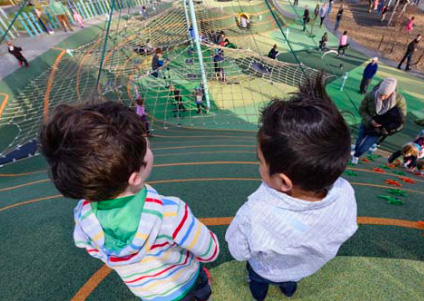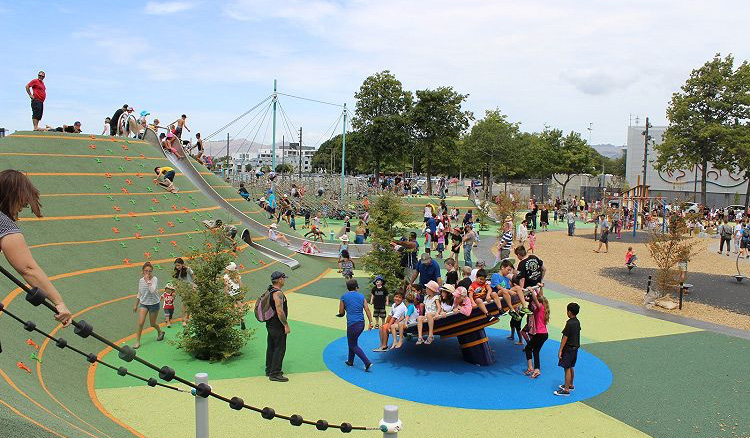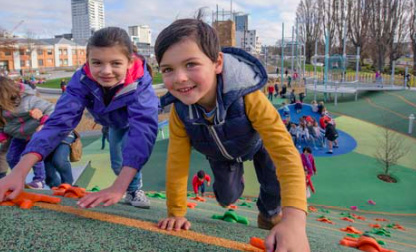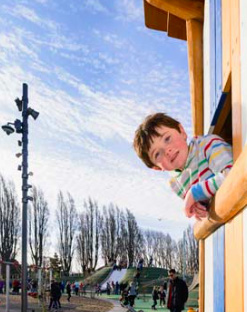Unfettered play
Text by Kathleen Kinney. Images by Opus
Community led design and managed risk are key to the success of the largest playground in the Southern Hemisphere
Most of us can recall the typical school or municipal playground of years gone by – the same barren stretch of hard-packed earth with metal-pipe based structures in the same configuration no matter what town or school it was. Much like eating McDonald’s, you knew that what you were getting was going to be the same wherever you were. And while it wasn’t necessarily awful, it wasn’t great either.
Is it any wonder we all decided it was far more fun to fling ourselves down tussocked hillsides, cross rushing streams and traipse into the bush?
But look through the city playgrounds and primary schoolyards today, and you’ll see that playspaces have come a long way.
The Margaret Mahy Family Playground is a case in point. From the outset it had an imperative far beyond merely offering a bog-standard destination for children at a loose end.
Just a few weeks after the 2011 Canterbury ‘quakes, the Canterbury Earthquake Recovery Authority (CERA) was established. Among the anchor projects identified for the Te Papa Otākaro/Avon River Precinct, was a City Playground.
Central to the plan’s success, both as a physical playspace and as an integral part of the emotional rebuilding of Christchurch, was getting the wider community involved on the ground level.
Catherine Hamilton of Opus, lead designer of the playspace, says this project, and those like it are a move back toward old-school neighbourhoods in which children were able, and encouraged, to play freely. Achieving this sort of public space “requires a commitment to the vision, meaningful community engagement and timely contribuion from child-centric advocates and professionals, throughout the planning and design... ”
To that end, more than 6000 Canterbury schoolchildren took part in the Amazing Place playground design competition run by the Christchurch Central Development Unit (CCDU). The judges had almost 300 entries to choose from, and the ultimate winners were four Year 6 pupils from Selwyn House School with their design inspired by Christchurch children’s author Margaret Mahy.
Lead designer Catherine Hamilon explains:
“The girls were actually just one of several winners, from local students in years five, six and seven. Then-prime minister John Key was there to announce the winners and hand out the awards, and he was really enthusiastic about the girls’ design in particular, and in a moment of excitement he just said off-the-cuff: ‘...the name of this new playground will be the Margaret Mahy Playground.’ So that pretty much decided it!
“The day I started as project manager, I was handed a booklet with all the winning designs, and those children became the primary focus group and stayed involved throughout the process.”
“Kids want to be scared and they want to be challenged ... they love to conquer their fear, and overcome a challenge”
Getting the end-users (the children) involved from the get-go is seen as the most effective way to create a playspace that truly engages children. It’s a philosophy that’s been increasingly included in urban revitalization plans worldwide.
“One of the delightful things about children is their unfettered imagination,” says Hamilton. “Margarent Mahy was an advocate of allowing childrens’ imaginations to run wild, and of engaging in unfettered play.”
But what does ‘unfettered play’ mean, and how can a constructed environment like a playground deliver that?
Hamilton and her contemporaries say that one of the universal constants in child-led playground is that kids ask for things that are scary and challenging. Thus an underlying concept for this, and other playgrounds is based on deliberate but managed risk.
“Children want to be scared and to be challenged, because they love to conquer their fear and overcome a challenge,” explains Hamilton.
At the New Zealand Recreation Association (NZRA) awards in November 2016, Opus was the winner of the Outstanding Project award for the design of the Margaret Mahy Family Playground. The playground was praised for the high level of play value and integration of play activities into a wider park setting; Opus’ extensive consultation with children and use of their ideas in the design; the use of vulcanised rubber to artistically resemble a New Zealand topo- graphical map, and for pushing the boundaries of challenge and managed risk.
Hamilton believes that the ‘winning trifecta’ consists of a landscape architecture-led holistic design, together with play specialists delivering a high level of play value and equipment supplier who are able to create customized proprietary equipment to fit the specific project criteria.
“This kind of community engagement enables children’s voices to be heard and lets those voices guide much of the design. The technical experts (the adults) then make it happen.
“The approach taken here, at the Margaret Mahy Playspace, is scaleable and transferable to any project”.
PROJECT LIST
Landscape Architects:
Opus Landscape Architecture
Wayne Stewart - Project Director
ayne Rimmer - Avon River Project Design Leader
Catherine Hamilton - Project Design Leader
Mark Devenny - Programme Delivery
Sarah Rowan - Project Landscape Architect
Client: CERA, Christchurch City Council and Te Rūnanga o Ngāi Tahu.
Collaborators and consultants: Tina Dyer, BDP, Landlab, Boffa Miskell, Colin Meurk,
Equipment Supplier: Playrope Ltd. Contractors: Citycare and John Fillmore.





